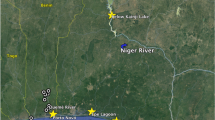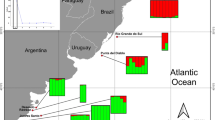Abstract
Restriction fragment-length polymorphisms of mitochondrial (mt) DNA, generated by six-base restriction enzymes, were used to examine the stock structure of the two major commercial species in New Zealand fisheries, orange roughy (Hoplostethus atlanticus Collett) and hoki (Macruronus novaezelandiae Hector). Samples of orange roughy from six spawning sites around New Zealand and one site off Tasmania show significant genetic heterogeneity. Samples from two sites around the south of New Zealand were genetically similar to each other, but dissimilar to samples from all other sites. The common haplotype observed in northern sites was absent from the two southern sites. Low numbers of unique haplotypes were restricted to the Challenger Plateau in the Tasman Sea. There was no significant genetic heterogeneity in five samples of hoki from two spawning sites off New Zealand and one site off Tasmania.
Similar content being viewed by others
References
Annala JH (1995) Report from the fishery assessment plenary, May 1995: stock assessments and yield estimates. MAF Fisheries Greta Point Library, Wellington, New Zealand (Unpublished Rep)
Anonymous (1994) The New Zealand seafood industry economic review 1993. New Zealand Fishing industry Board, Wellington
Baker CS, MacCarthy M, Smith PJ, Perry AP, Chambers GK (1992) DNA fingerprints of orange roughy, Hoplostethus atlanticus: a population comparison. Mar Biol 113: 561–567
Baker CS, Perry A, Chambers GK, Smith PJ (1995) Population variation in the mitochondrial cytochrome b gene of the orange roughy Hoplostethus atlanticus and hoki Macruronus novaezelandiae. Mar Biol 122: 503–509
Black M, Dixon PI (1989) Population structure of orange roughy (Hoplostethus atlanticus) in Australian waters. Centre for Marine Science, University of New South Wales, Kensington, Australia (Internal Rep)
Bowen BW, Avise JC (1990) Genetic structure of Atlantic and Gulf of Mexico populations of sea bass, menhaden, and sturgeon: influence of zoogeographic factors and life-history patterns. Mar Biol 107: 371–381
Brasher DJ, Ovenden JR, Booth JD, White RWG (1992) Genetic subdivision of Australian and New Zealand populations of Jasus verrauxi (Decapoda: Palinuridae) — preliminary evidence from the mitochondrial genome. NZ Jl mar Freshwat Res 26: 53–58
Brown WM (1983) Evolution of animal mitochondrial DNA. In Nei M, Koehn RK (eds) Evolution of genes and proteins. Sinauer, Sunderland, pp 62–88
Bulman CM, Blaber SJM (1986) Feeding ecology of Macruronus novaezelandiae (Hector) (Teleostei: Merlucciidae) in south-eastern Australia. Aust J mar Freshwat Res 37: 621–639
Chapman RW, Powers DA (1984) A method for the rapid isolation of mitochondrial DNA from fishes. Tech Rep Univ Md Sea Grant Progm UM-SGTS 84-05: 1–11
Clark M (1990) A review of stock structure of orange roughy (Hoplostethus atlanticus) in the New Zealand EEZ and Tasman Sea. MAF Fisheries, Greta Point, Wellington, New Zealand (Internal Rep No. 144)
Crosetti D, Nelson WS, Avise JC (1994) Pronounced genetic structure of mitochondrial DNA among populations of the circumglobally distributed grey mullet (Mugil cephalus) J Fish Biol 44: 47–58
Edmonds JS, Caputi N, Morita M (1991) Stock discrimination by trace element analysis of otoliths of orange roughy (Hoplostethus atlanticus) a deep-water marine teleost. Aust J mar Freshwat Res 42: 383–389
Elliot NG, Smolenski AJ, Ward RD (1994) Allozyme and mitochondrial DNA variation in orange roughy, Hoplostethus atlanticus (Teleostei: Trachichthyidae): little differentiation between Australian and North Atlantic populations. Mar Biol 119: 621–627
Elliot NG, Ward RD (1992) Enzyme variation in orange roughy (Hoplostethus atlanticus) samples from southern Australian and New Zealand waters. Aust J mar Freshwat Res 45:51–67
Excoffier L, Smouse PE, Quattro JM (1992) Analysis of molecular variance inferred from metric distances among DNA haplotypes: application to human mitochondrial DNA restriction data. Genetics, Princeton 131: 479–491
Fenton GE, Short SA, Ritz DA (1991) Age determination of orange roughy, Hoplostethus atlanticus (Pisces: Trachichthyidae) using 210Pb:226Ra disequilibria. Mar Biol 109: 197–202
Gilmour AE, Cole AG (1979) The subtropical convergence east of New Zealand. NZ Jl mar Freshwat Res 13: 553–557
Gold JR, Richardson LR (1991) Genetic studies in marine fishes. IV. An analysis of population structure in red drum (Sciaenops ocelatus) using mitochondrial DNA. Fish Res 12: 213–241
Gold JR, Richardson LR (1994) Mitochondrial DNA variation among ‘red’ fishes from the Gulf of Mexico. Fish Res 20: 137–150
Graves JE, McDowell JR, Jones ML (1992) A genetic analysis of weakfish Cynoscion regalis stock structure along the mid-Atlantic coast. Fish Bull US 90: 469–475
Grewe PM, Smolenski AJ, Ward RD (1994) Mitochondrial DNA diversity in jackass morwong (Nemadactylus macropterus: Teleostei) from Australian and New Zealand waters. Can J Fish aquat Sciences 51: 1101–1109
Heath RA (1975) Oceanic circulation and hydrology off the southern half of South Island, New Zealand. Mem NZ oceanogr Inst 72: 1–36
Kuo C-L, Tanaka S (1984) Maturation and spawning of hoki Macruronus novaezelandiae (Hector) in waters around New Zealand. Bull Jap Soc scient Fish 50: 397–402
Lester RJG (1990) Reappraisal of the use of parasites for fish stock identification. Aust J mar Freshwat Res 41: 855–864
Lester RJG, Sewell KB, Barnes A, Evans K (1988) Stock discrimination of orange roughy Hoplostethus atlanticus by parasite analysis. Mar Biol 99: 137–143
Livingston ME (1990) Spawning hoki (Macruronus novaezelandiae Hector) concentrations in Cook Strait and off the east coast of the South Island, New Zealand, August–September 1987. NZ Jl mar Freshwat Res 24: 503–517
Mace PM, Fenaughty JM, Coburn RP, Doonan IJ (1990) Growth and productivity of orange roughy (Hoplostethus atlanticus) on the North Chatham Rise. NZ Jl mar Freshwat Res 24: 105–119
Maniatis T, Fritsch EF, Sambrook J (1982) Molecular cloning. A laboratory manual. Cold Spring Harbor Laboratory, Cold Spring Harbor, New York
May JL, Blaber SJM (1989) Benthic and pelagic fish biomass of the upper continental slope off eastern Tasmania. Mar Biol 101: 11–25
McElroy D, Moran P, Bermingham E, Kornfield I (1992) REAP: an integrated environment for the manipulation and phylogenetic analysis of restriction data. J Hered 83: 157–158
Milton DA, Shaklee JB (1987) Biochemical genetics and population structure of blue grenadier Macruronus novaezelandiae (Pisces; Merlucciidae) from Australia. Aust J mar Freshwat Res 38: 727–742
Nei M (1973) Analysis of gene diversity in subdivided populations. Proc natn Acad Sci USA 70: 3321–3323
Nei M, Tajima F (1981) DNA polymorphisms detectable by restriction endonucleases. Genetics, Princeton 97: 145–163
Ovenden JR, Brasher DJ, White RWG, (1992) Mitochondrial DNA anaysis of the red rock lobster Jasus edwardsii supports an apparent absence of population subdivision throughout Australia. Mar Biol 112: 319–326
Ovenden JR, Smolenski AJ, White RWG (1989) Mitochondrial DNA restriction site variation in Tasmanian populations of orange roughly (Hoplostethus atlanticus) a deep water marine teleost. Aust J mar Freshwat Res 40: 1–9
Pankhurst NW (1988) Spawing dynamics of orange roughy Hoplostethus atlanticus, in midslope waters of New Zealand. Envir Biol Fish 21: 101–116
Patchell GJ (1982) The New Zealand hoki fisheries 1972–82. Occ Publs Fish Res Div NZ Minist Agric Fish 38: 1–23
Paul LJ (1986) New Zealand fishes: an identification guide. Reed Methuen, Auckland, New Zealand
Rice WR (1989) Analyzing tables of statistical tests. Evolution 43: 223–225
Richardson BJ (1982) Geographical distribution of electrophoretically detected protein variation in Australian commercial fishes. 11. Jackass morwong Cheilodactylus macropterus Bloch & Schneider. Aust J mar Freshwat Res 33: 927–931
Roberts PE (1980) Surface distribution of albacore tuna Thunnus alalunga Bonnaterre, in relation to the subtropical convergence zone east of New Zealand. NZ Jl mar Freshwat Res 14: 373–380
Robertson DA (1991) The New Zealand orange roughy fishery: an overview. In: Abel K, Williams M, Smith P (eds) Australian and New Zealand Southern Trawl Fisheries Conference: issues and opportunities. Bureau of Rural Resources. Canberra, Australia, pp 38–48 (Proc No 10)
Robertson DA, Roberts PE, Wilson JB (1978) Mesopelagic faunal transition across the subtropical convergence east of New Zealand. NZ Jl mar Freshwat Res 12: 295–312
Roff DA, Bentzen P (1989) The statistical analysis of mitochondrial DNA polymorphisms: χ2 and the problem of small samples. Molec Biol Evolut 6: 539–545
Slatkin M (1987) Gene flow and the geographic structure of natural populations. Science, NY 236: 787–792
Smith PJ (1986) Genetic similarity between samples of the orange roughy Hoplostethus atlanticus from the Tasman Sea, South-west Pacific Ocean and North-east Atlantic Ocean. Mar Biol 91: 173–180
Smith PJ, McKoy JL, Machin PJ (1980) Genetic variation in the rock lobsters Jasus edwardsii and J. novaehollandiae. NZ Jl mar Freshwat Res 14: 55–63
Smith PJ, Patchell GJ, Benson PG (1981) Genetic tags in the New Zealand hoki, Macruronus novaezelandiae. Anim Blood Grps biochem Genet 12: 37–45
Smolenski AJ, Ovenden JR, White RWG (1993) Evidence of stock separation in southern hemisphere orange roughy (Hoplostethus atlanticus, Trachichthyidae) from restriction-enzyme analysis of mitochondrial DNA. Mar Biol 116: 219–230
Sullivan KJ, Cordue PL (1994) A review of the 1991–92 hoki fishery and assessment of hoki stocks for 1993. NZ Assessment Res Docs (MAF, Wellington) 94/2: 1–19
Takahata N, Palumbi SR (1985) Extranuclear differentiation and gene flow in the finite island model. Genetics, Princeton 109: 441–457
Thresher RE, Bruce BD, Furlani DM, Gunn SS (1989) Distribution, advection and growth of larvae of the southern temperate gadoid, Macruronus novaezelandiae (Teleostei: Merlucciidae) in Australian coastal waters. Fish Bull US 87: 29–48
Tilzey RDJ (1994) The southeast fishery: a scientific review with particular reference to quota management. Bureau of Resource Sciences, Canberra
Ward RD, Elliot NG, Grewe PM, Smolenski AJ (1994) Allozyme and mitochondrial DNA variation in yellowfin tuna (Thunnus albacares) from the Pacific Ocean. Mar Biol 118: 531–539
Wright S (1943) Isolation by distance. Genetics, Princeton 28: 114–138
Zeldis JR, Grimes PJ, Ingerson JKV (1994) Ascent rates, vertical distribution, and a thermal history model of development of orange roughy, Hoplostethus atlanticus, eggs in the water column. Fish Bull US 93: 373–385
Author information
Authors and Affiliations
Additional information
Communicated by G. F. Humphrey, Sydney
Rights and permissions
About this article
Cite this article
Smith, P.J., McVeagh, S.M. & Ede, A. Genetically isolated stocks of orange roughy (Hoplostethus atlanticus), but not of hoki (Macruronus novaezelandiae), in the Tasman Sea and Southwest Pacific Ocean around New Zealand. Marine Biology 125, 783–793 (1996). https://doi.org/10.1007/BF00349261
Received:
Accepted:
Issue Date:
DOI: https://doi.org/10.1007/BF00349261




